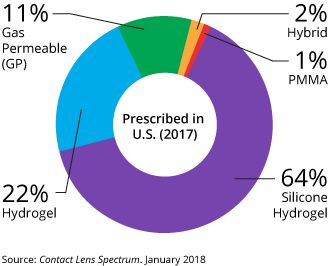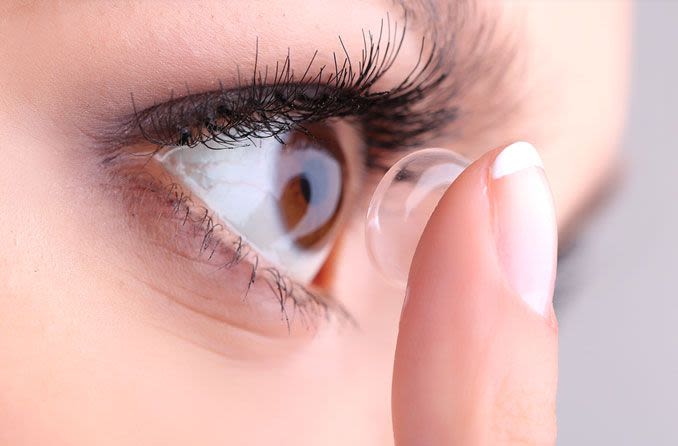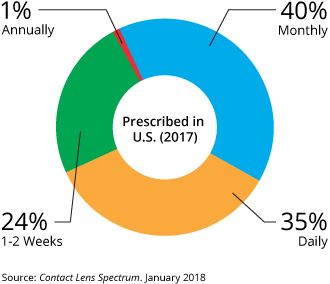Computer Vision Syndrome, also referred to as Digital Eye Strain, describes a group of eye and vision-related problems that result from prolonged computer, tablet, e-reader and cell phone use. Many individuals experience eye discomfort and vision problems when viewing digital screens for extended periods. The level of discomfort appears to increase with the amount of digital screen use.
The average American worker spends seven hours a day on the computer either in the office or working from home. March is Save Your Vision Month and the American Optometric Association is working to educate both employers and employees about how to avoid digital eye strain in the workplace. To help alleviate digital eye strain, follow the 20-20-20 rule; take a 20-second break to view something 20 feet away every 20 minutes.
Click here for helpful infographics about the 20-20-20 rule and digital eye strain.
 The most common symptoms associated with Computer Vision Syndrome (CVS) or Digital Eye Strain are
The most common symptoms associated with Computer Vision Syndrome (CVS) or Digital Eye Strain are
- eyestrain
- headaches
- blurred vision
- dry eyes
- neck and shoulder pain
These symptoms may be caused by:
- poor lighting
- glare on a digital screen
- improper viewing distances
- poor seating posture
- uncorrected vision problems
- a combination of these factors
- The extent to which individuals experience visual symptoms often depends on the level of their visual abilities and the amount of time spent looking at a digital screen. Uncorrected vision problems like farsightedness and astigmatism, inadequate eye focusing or eye coordination abilities, and aging changes of the eyes, such as presbyopia, can all contribute to the development of visual symptoms when using a computer or digital screen device.Many of the visual symptoms experienced by users are only temporary and will decline after stopping computer work or use of the digital device. However, some individuals may experience continued reduced visual abilities, such as blurred distance vision, even after stopping work at a computer. If nothing is done to address the cause of the problem, the symptoms will continue to recur and perhaps worsen with future digital screen use.Prevention or reduction of the vision problems associated with Computer Vision Syndrome or Digital Eye Strain involves taking steps to control lighting and glare on the device screen, establishing proper working distances and posture for screen viewing, and assuring that even minor vision problems are properly corrected.What causes Computer Vision Syndrome or Digital Eye Strain?Viewing a computer or digital screen often makes the eyes work harder. As a result, the unique characteristics and high visual demands of computer and digital screen device viewing make many individuals susceptible to the development of vision-related symptoms.
 Uncorrected vision problems can increase the severity of Computer Vision Syndrome or Digital Eye Strain symptoms.Viewing a computer or digital screen is different than reading a printed page. Often the letters on the computer or handheld device are not as precise or sharply defined, the level of contrast of the letters to the background is reduced, and the presence of glare and reflections on the screen may make viewing difficult.
Uncorrected vision problems can increase the severity of Computer Vision Syndrome or Digital Eye Strain symptoms.Viewing a computer or digital screen is different than reading a printed page. Often the letters on the computer or handheld device are not as precise or sharply defined, the level of contrast of the letters to the background is reduced, and the presence of glare and reflections on the screen may make viewing difficult.
Viewing distances and angles used for this type of work are also often different from those commonly used for other reading or writing tasks. As a result, the eye focusing and eye movement requirements for digital screen viewing can place additional demands on the visual system.
In addition, the presence of even minor vision problems can often significantly affect comfort and performance at a computer or while using other digital screen devices. Uncorrected or under corrected vision problems can be major contributing factors to computer-related eyestrain.
Even people who have an eyeglass or contact lens prescription may find it’s not suitable for the specific viewing distances of their computer screen. Some people tilt their heads at odd angles because their glasses aren’t designed for looking at a computer. Or they bend toward the screen in order to see it clearly. Their postures can result in muscle spasms or pain in the neck, shoulder or back.
In most cases, symptoms of CVS or Digital Eye Strain occur because the visual demands of the task exceed the visual abilities of the individual to comfortably perform them. At greatest risk for developing CVS or Digital Eye Strain are those persons who spend two or more continuous hours at a computer or using a digital screen device every day.
How is Computer Vision Syndrome or Digital Eye Strain diagnosed?
Computer Vision Syndrome, or Digital Eye Strain, can be diagnosed through a comprehensive eye examination. Testing, with special emphasis on visual requirements at the computer or digital device working distance, may include:
- Patient history to determine any symptoms the patient is experiencing and the presence of any general health problems, medications taken, or environmental factors that may be contributing to the symptoms related to computer use.
- Visual acuity measurements to assess the extent to which vision may be affected.
- A refraction to determine the appropriate lens power needed to compensate for any refractive errors (nearsightedness, farsightedness or astigmatism).
- Testing how the eyes focus, move and work together. In order to obtain a clear, single image of what is being viewed, the eyes must effectively change focus, move and work in unison. This testing will look for problems that keep your eyes from focusing effectively or make it difficult to use both eyes together.
This testing may be done without the use of eye drops to determine how the eyes respond under normal seeing conditions. In some cases, such as when some of the eyes’ focusing power may be hidden, eye drops may be used. They temporarily keep the eyes from changing focus while testing is done.
Using the information obtained from these tests, along with results of other tests, your optometrist can determine if you have Computer Vision Syndrome or Digital Eye Strain and advise you on treatment options.
How is Computer Vision Syndrome, or Digital Eye Strain treated?
Solutions to digital screen-related vision problems are varied. However, they can usually be alleviated by obtaining regular eye care and making changes in how you view the screen.
Eye Care
In some cases, individuals who do not require the use of eyeglasses for other daily activities may benefit from glasses prescribed specifically for computer use. In addition, persons already wearing glasses may find their current prescription does not provide optimal vision for viewing a computer.
- Eyeglasses or contact lenses prescribed for general use may not be adequate for computer work. Lenses prescribed to meet the unique visual demands of computer viewing may be needed. Special lens designs, lens powers or lens tints or coatings may help to maximize visual abilities and comfort.
- Some computer users experience problems with eye focusing or eye coordination that can’t be adequately corrected with eyeglasses or contact lenses. A program of vision therapy may be needed to treat these specific problems. Vision therapy, also called visual training, is a structured program of visual activities prescribed to improve visual abilities. It trains the eyes and brain to work together more effectively. These eye exercises help remediate deficiencies in eye movement, eye focusing and eye teaming and reinforce the eye-brain connection. Treatment may include office-based as well as home training procedures.
Viewing the Computer

Proper body positioning for computer use.
Some important factors in preventing or reducing the symptoms of CVS have to do with the computer and how it is used. This includes lighting conditions, chair comfort, location of reference materials, position of the monitor, and the use of rest breaks.
- Location of computer screen – Most people find it more comfortable to view a computer when the eyes are looking downward. Optimally, the computer screen should be 15 to 20 degrees below eye level (about 4 or 5 inches) as measured from the center of the screen and 20 to 28 inches from the eyes.
- Reference materials – These materials should be located above the keyboard and below the monitor. If this is not possible, a document holder can be used beside the monitor. The goal is to position the documents so you do not need to move your head to look from the document to the screen.
- Lighting – Position the computer screen to avoid glare, particularly from overhead lighting or windows. Use blinds or drapes on windows and replace the light bulbs in desk lamps with bulbs of lower wattage.
- Anti-glare screens – If there is no way to minimize glare from light sources, consider using a screen glare filter. These filters decrease the amount of light reflected from the screen.
- Seating position – Chairs should be comfortably padded and conform to the body. Chair height should be adjusted so your feet rest flat on the floor. If your chair has arms, they should be adjusted to provide arm support while you are typing. Your wrists shouldn’t rest on the keyboard when typing.
- Rest breaks – To prevent eyestrain, try to rest your eyes when using the computer for long periods. Rest your eyes for 15 minutes after two hours of continuous computer use. Also, for every 20 minutes of computer viewing, look into the distance for 20 seconds to allow your eyes a chance to refocus.
- Blinking – To minimize your chances of developing dry eye when using a computer, make an effort to blink frequently. Blinking keeps the front surface of your eye moist.
Regular eye examinations and proper viewing habits can help to prevent or reduce the development of the symptoms associated with Computer Vision Syndrome.
If you are having signs or symptoms of computer vision syndrome, call or visit:
Eye update Eye clinic & opticals 01, Ajuwon junction, Ajuwon bus stop, beside BNPL filling station, Akute/Ajuwon road, off Elliot bus stop, Iju-Ishagah near Alagbole Fagba. Tel: 0803497158, 08107531046.
This information will reach people within the following areas and yonder:
Obawole, fagba, ifako,ijaye, near, ancillia,agege, iju, road,alagbole, akute, ajuwon, lambe, matogun, matogbun, giwa, okearo, koye, oke, arifanla, baale, Road, fagba, abule, egba, agege, ogba, ikeja, G. R. A, oshodi, Berger, ojodu, omole, magodo, yaba, mowe, ibafo, shagamu, Ishagah, shomolu, heritage, estate, shagamu, bola ahmed tinubu road, kudirat abiola estate, grailand estate, heritage estate, ajao, College Road, iju, Road, water, works, omole, magado, ketu, ojota, ikoyi, akiode bus stop, obawale, grammar school, first gate, Ala Hausa, Yoruba, Igbo, Benin, Edo, Association, Club, Ikorodu, Ketu, Ojota, Elliot, Iju, Ishagah, Fagba, ojodu, best, eye clinic, optical, toll gate, Ikeja, ojota, maryland, oshodi, apapa, ogba, College Road, near bank, station, agege, Abeokuta, sango ota, otta, Lisa, mowe ibafo, redeem camp, Lagos, Ibadan, gold valley estate, isheri, iseri pole phase 1, implemented phase II, grammar school, testing ground, jankara, alagbado, koye oke, oshere, osere, matogun, matogbun, olambe, lambe, tipper garage, otun, jolasco, Victoria Island, festac, vgc, eko atlantic, Victoria garden City, ikorodu, ketu, ajegunle, abule egba, fagba, grailand, Berger, Obawale,Agege, Pencinema,Shomolu, Cele, Ogun, Lagos, Lagos Island, Lagos mainland, Ifako, Ijaye, eti osa, Oyo, Lisa, Owode, sang ota, abule egba, redeem camp, Ijebu ode, toll gate, bus stop, Street, along, Nigeria












 The most common symptoms associated with Computer Vision Syndrome (CVS) or Digital Eye Strain are
The most common symptoms associated with Computer Vision Syndrome (CVS) or Digital Eye Strain are Uncorrected vision problems can increase the severity of Computer Vision Syndrome or Digital Eye Strain symptoms.Viewing a computer or digital screen is different than reading a printed page. Often the letters on the computer or handheld device are not as precise or sharply defined, the level of contrast of the letters to the background is reduced, and the presence of glare and reflections on the screen may make viewing difficult.
Uncorrected vision problems can increase the severity of Computer Vision Syndrome or Digital Eye Strain symptoms.Viewing a computer or digital screen is different than reading a printed page. Often the letters on the computer or handheld device are not as precise or sharply defined, the level of contrast of the letters to the background is reduced, and the presence of glare and reflections on the screen may make viewing difficult.





